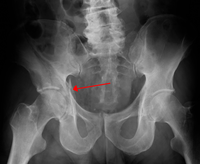
Photo from wikipedia
Background A coronal comminuted femoral intertrochanteric fracture is a special type of fracture that easily leads to internal fixation failure, and the current internal fixation techniques remain controversial. This study… Click to show full abstract
Background A coronal comminuted femoral intertrochanteric fracture is a special type of fracture that easily leads to internal fixation failure, and the current internal fixation techniques remain controversial. This study aims to evaluate the effect of traction-bed-assisted reduction and double-plate internal fixation in the treatment of comminuted and coronally split intertrochanteric femoral fracture. Method Retrospective analyses of the clinical data of 83 patients diagnosed with, and treated for, comminuted and coronally split intertrochanteric femoral fracture from December 2017 to November 2019 were conducted. Among the total number of 83 patients, 40 patients received traction-bed-assisted reduction and PFNA fixation (the control group), whereas 43 patients received traction-bed-assisted reduction and double-plate internal fixation (the experimental group). The major indicators for the research analysis such as the general information of patients, perioperative data, and follow-up data of both groups were collected, sorted out, and meticulously analyzed. Results The time taken for traction-bed-assisted reduction and double-plate intern fixation in the experimental group was significantly shorter than that in the control group (P < .05). The post-operative Harris Hip Score (HHS) at 3 months and at the final follow-up after the surgery was significantly better in the experimental group compared with that in the control group, both of which were statistically significant (P < .05). However, there were statistically no significant differences between the two groups in terms of preoperative hemoglobin (Hb) level, amount of intraoperative total blood loss, immediate post-operative Hb level, incidence of wound infection within 14 days post-operatively, time taken to step up on the ground after surgery, HHS 2 weeks after surgery, time taken for fracture healing, and the incidence of complications (P > .05). Conclusion The use of a traction bed to achieve adequate reduction, followed by internal fixation using double plates, comparatively takes less time for both reduction and operation in the treatment of comminuted and coronally split intertrochanteric femoral fractures, which also restores proper hip joint movements relatively early and hence provides better hip joint functions in the long run.
Journal Title: Frontiers in Surgery
Year Published: 2022
Link to full text (if available)
Share on Social Media: Sign Up to like & get
recommendations!